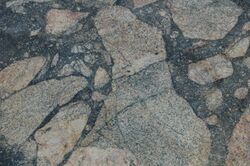Astronomy:Pseudotachylite

Pseudotachylite or Pseudotachylyte (original spelling) is a cohesive glassy or very fine-grained rock that occurs as veins and often contains inclusions of wall-rock fragments. Pseudotachylite is typically dark in color; and is glassy in appearance. It was named after its appearance resembling the basaltic glass, tachylyte. Typically, the glass is completely devitrified into very fine-grained material with radial and concentric clusters of crystals. The glass may also contain crystals with quench textures that formed via crystallization from the melt.[1][2] Chemical composition of pseudotachylyte generally reflects the local bulk chemistry. Pseudotachylyte may form via frictional melting of faults, in large-scale landslides, and by impact processes. Many researchers often define the rock as one formed via the melting (c.f. fault rock). However, the original description/definition by Shand[3] did not include interpretation about its generation, and it is suggested that there are pseudotachylytes formed via comminution without melting (e.g. Wenk, 1978).
Formation
Seismic faulting
It is found either along fault surfaces (fault vein type), as the matrix to a fault breccia (pseudotachylite breccia), or as veins injected into the walls of the fault (injection vein type). In most cases, researchers search for and describe good evidence that the pseudotachylite formed by frictional melting of the wall rocks during rapid fault movement associated with a seismic event.[4] This has caused them to be termed "fossil earthquakes".[5] The thickness of the pseudotachylite zone is indicative of the magnitude of the associated displacement and the general magnitude of the paleoseismic event. Some pseudotachylites have been interpreted as forming by comminution rather than melting. They have a similar occurrence to melt-derived pseudotachylites but lack clear indications of a melt origin.[5]
Landslides
Pseudotachylite has been found at the base of some large landslides involving the movement of large coherent blocks,[6] such as the one that moved Heart Mountain in the U.S. state of Wyoming to its present location, the largest known landslide in history on land.
Impact structures

Pseudotachylite is also associated with impact structures. In an impact event, melting forms as part of the shock metamorphic effects.[7] Pseudotachylite veins associated with impacts are much larger than those associated with faults. Impact-generated veins form by frictional effects within the crater floor and below the crater during the initial compression phase of the impact and the subsequent formation of the central uplift.[8] The most extensive examples of impact related pseudotachylites come from impact structures that have been deeply eroded to expose the floor of the crater, such as Vredefort crater, South Africa and the Sudbury Basin, Canada. The first described pseudotachylyte is of this type.[3]
See also
References
- ↑ Maddock, R.H. (1983) Melt origin of fault-generated pseudotachylites demonstrated by textures. Geology. 11(6):105–108.
- ↑ Trouw, R.A.J., C.W. Passchier, and D.J. Wiersma (2010) Atlas of Mylonites- and related microstructures. Springer-Verlag, Berlin, Germany. 322 pp. ISBN:978-3-642-03607-1
- ↑ 3.0 3.1 Shand, S. James (1916-02-01). "The Pseudotachylyte of Parijs (Orange Free State), and its Relation to ‘Trap-Shotten Gneiss’ and ‘Flinty Crush-Rock’" (in en). Quarterly Journal of the Geological Society 72 (1-4): 198–221. doi:10.1144/GSL.JGS.1916.072.01-04.12. ISSN 0370-291X. http://jgslegacy.lyellcollection.org/content/72/1-4/198.
- ↑ Sibson, R.H., 1975. Generation of pseudotachylite by ancient seismic faulting. Geophysical Journal of the Royal Astronomical Society 43, 775– 794.
- ↑ 5.0 5.1 Lin, A. (2007). Fossil earthquakes: the formation and preservation of Pseudotachylytes. Lecture Notes in Earth Sciences. 111. Springer. pp. 348. ISBN 978-3-540-74235-7. https://books.google.com/books?id=WEhtJn_KAUIC&dq=%22fossil+earthquakes%22&printsec=frontcover&source=bl&ots=2QPWKsAduw&sig=zDjyn_EY8A-HnYtAjfi1oE6W3Iw&hl=en&ei=hbnuSqeUDKCNjAf-6eSaDQ&sa=X&oi=book_result&ct=result&resnum=3&ved=0CBEQ6AEwAg#v=onepage&q=&f=false. Retrieved 2009-11-02.
- ↑ Legros, F., Cantagrel, J-M. & Devouard, B. 2000. Pseudotachylyte (Frictionite) at the Base of the Arequipa Volcanic Landslide Deposit (Peru): Implications for Emplacement Mechanisms. The Journal of Geology, volume 108, p. 601–611.
- ↑ Spray, J.G. 1998. Localized shock- and friction-induced melting in response to hypervelocity impact. Journal of the Geological Society, London, Special Publication, 140, 195-204.
- ↑ Chapter 5 of the online book, French, B.M. 1998. Traces of Catastrophe, A handbook of shock-metamorphic effects in terrestrial meteorite impact structures, Lunar and Planetary Institute 120pp.
External links
Wieland, F. (2006) Chapter 4: Pseudotachylitic breccias, other breccias and veins. Structural analysis of impact-related deformation in the collar rocks of the Vredefort Dome, South Africa. unpublished PhD. dissertation. School of Geosciences, University of the Witwatersrand, Johannesburg, South Africa.
